In front of me I see a mud-free fork in the road. Finally!
The sweat runs in streams from my face and I need to rest urgently and eat something. For what feels like an hour I've been dragging my huge, heavy XL mountain bike including heavy backpack on my shoulders through the muddy track.
We want to camp and climb the night in Jaruco at the rockclimbing sector La Jaula. But we did not expect these mud masses and are struggeling with climbing equipment, food supplies and tents step by step through the forest and meadows to the village of Jaruco in central Cuba.
At the fork in the road, we just let ourselves fall powerlessly into the grass together with our bicycles. A sudden noise makes us sit up and take notice: a huge fat pink pig looks at us with big eyes. Where have we landed here?
I walk along the fork and can't believe my eyes - the path to the left as well as the one to the right is closed with a gate. Damn! Are we lost? Where the hell are the others?

Climbing excursion off the beaten track
We are nine climbers from Havana's bouldering community who want to go to Jaruco.
Havana is in “phase 3” regarding the coronavirus, which means that we are not actually allowed out of Havana province yet and there is no public transportation.
The village of Jaruco with the climbing rock La Jaula is located in Mayabeque province in central Cuba.
Our plan is to camp in Jaruco and escape the checkpoint by bike on a route por el monte (means across the country).
Such a trip has to be well planned. Here, according to our organizer today, Pablo, there are no supply possibilities, only a well nearby.
We don't know what to expect - only that the bolts on the rock have not been maintained for a long time and are supposed to be rusty, and that the last time someone was on the rock before Corona was about 1.5 years ago.
Camping in the middle of the nowhere needs to be well planned
So we meet the night before at Danny's house in the Cerro district and distribute the luggage.
4 of the 10 of us have a carrier on the bike and will transport the tents. We divide the heaviest equipment fairly among ourselves. These are the climbing ropes, exes (carabiner slings) and the machetes to be able to clear the way to the rock.
Afterwards we make a list of the food and see what else we might need. On site we want to cook spaghetti. For snacks and breakfast we will have cookies, bread, mayonnaise and tuna. Water we want to get directly on site.
For this, everyone should take an empty 5 liter water canister with them to get the water for washing from the well.
Then we still divide the smaller travel utensils, which should be present at least in unique version: First aid kit, wheel patches, kerosene for making fire, cooking utensils, etc.
The early bird catches the worm
At 3.30 o'clock my alarm clock rings.
I jump out of bed unusually awake for this time of day, because I have hardly slept at all.
The excitement and the uncertainty of what to expect in Jaruco have been playing havoc in my subconscious and have pulled me out of another dream.
In Havana Vieja we all meet. Despite a sleepy look, we are all in high spirits and excitedly start our adventure.
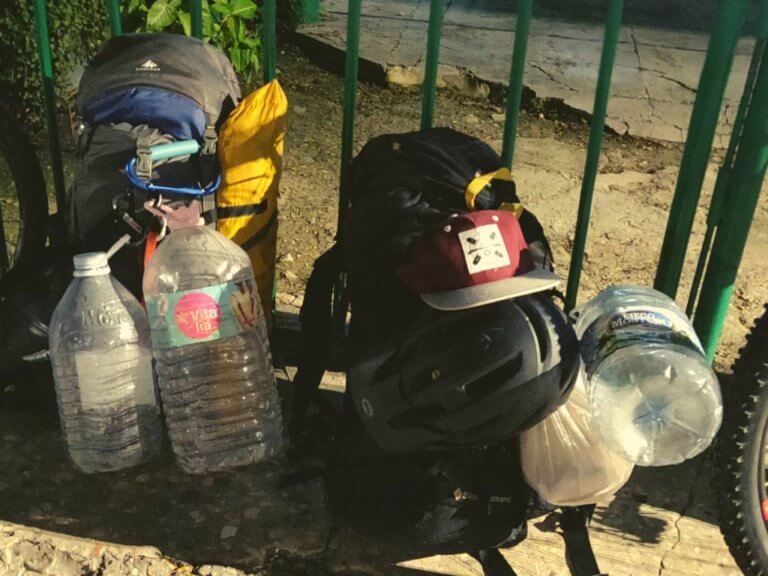
Havana's nightlife
We make our way past the Havana train station and into the industrial area by the port. Good thing we remembered the lights.
Here where the overland road Via Blanca begins, there is an incredible amount of traffic, even early in the morning. The intersections are confusing.
Thank God Pablo knows his way around, because my sense of direction has already left me. Here in the port industrial area we recognize the outlines of huge cranes and containers in the darkness.
As we drive through the Regla district, notorious for its Santeriakult, we are met by masses of nocturnal partygoers. Officially there are still no parties in Cuba because of Corona, but the sociable Cubans organize then just home parties.
Finally we are also in Guanabacoa through and out of the city. It is still dark and the black outlines of huge royal palms pave our way under a starry sky.


Where fox and rabbit say good night to one another
After strapping our loose luggage back on near Alamar and eating some mani (peanuts) for breakfast, we collect Juan and Ramiro and enjoy a gorgeous sunrise in the countryside.
We whiz down the hills of the country road and are enchanted by outlines of the Cuban Känigspalmen surrounded by white mist and gorgeous, golden morning red.
May I have many more sunrises like this!
We cross small villages, among others Bacuranao, La Gallega, Las Minas and finally reach Arango. We gather at the village square with the pretty little church. The villagers are already on the streets at 8 o'clock in the morning, because the Cubans are used to go shopping very early.
Here in Cuba the motto is"he who comes too late is punished by life", because often only a limited ration of one product is sold every day.
Curious we are patterned, because since the outbreak of the Coronavirus seven months ago probably nobody has seen a group of cyclists packed with tents. We buy some home-made Cuban juice, unfortunately there is nothing more to get here. Wistfully I look into a storage room of an adjacent house. Here, egg cartons are piled high.
I would love to buy some right away, because eggs have also become a scarce commodity in Havana and without a ration card they are almost only overpriced and rarely found on the black market.

Have we really thought this through?
"Wouldn't we rather continue on the country road? I have such a queasy feeling that a muddy track awaits us,"I still said to Ramiro, who knows the mountain bike routes here in the Campo(in the countryside) very well.
"No, on the country road we come to the punto control (police checkpoint) of Mayabeque.. Don't worry - it hasn't rained in three days, the trails are dry.""
Well then, off into the bush!
From Arango, we turn onto a dirt road that will take us about 11 kilometers que through the pampas to Santa Barbara. The sun rises and bathes the dewy dirt roads in golden light.
Cheering, the nasobucos Cuban for mouth guards) are stowed away and we breathe in the fresh country air deeply and liberated. Finally out of Havana and far away from the Corona virus and the oldtimer-polluted air! Did we miss that!
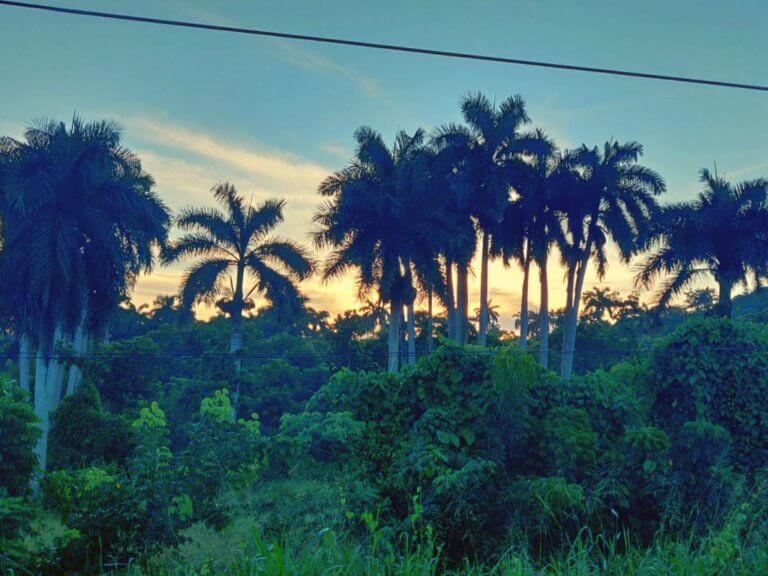

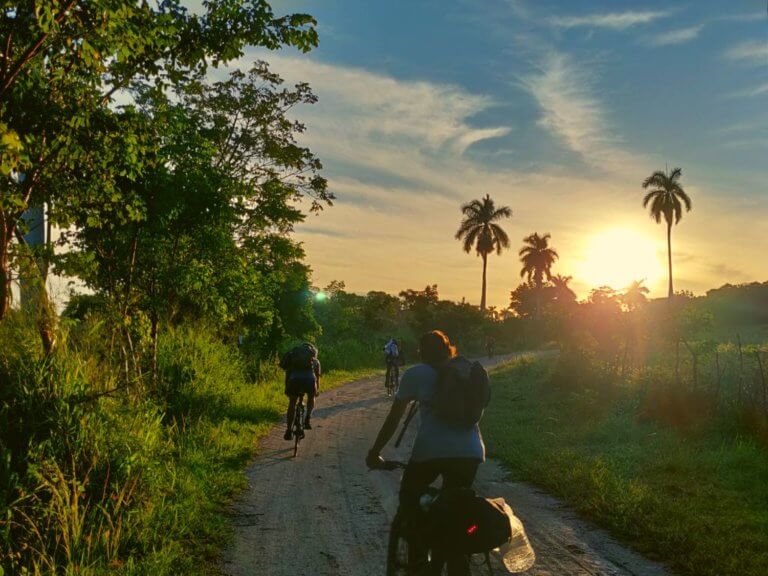
Mud track
But soon our laughter fades. In front of us is a muddy track. Ramiro thinks it is the only way, he has driven it many times before."The mud is only here at this point, further ahead it will be better again," he said.
So shouldering wheels and fighting forward. With the heavy backpack including tent and climbing gear and my XL mountain bike, it's not so easy.
With Yanni in the lead we start to wade through the mud with shouldered bikes. After about an hour, we come to a mud-free intersection. Exhausted, I drop into the grass with Yanni.
"Hey, that's as far as we can go, there are only cow pastures far and wide," a passing farmer calls out to us from a distance.
But suddenly something catches my eye."Hey, let's wait for Ramiro. I've been here before. This is the road to the La Coca reservoir and back then we turned around because the road was just impassable.""


Lost somewhere in the middle of nowhere
Where are the others? Far and wide there is no one to be seen. While concentrating on mud wading, Yanni and I ate everything around us and didn't even look back. We use the break and eat ham baguettes and torticas (thick Cuban butter dough cookies with a looooooot of sugar).
Still we hear nothing. Yanni starts calling for the others, but nobody answers. Hopefully we are not lost. We wait and wait. The fork in the road where we are sitting is crossed on both sides by cattle. Does it go on to the right or to the left?
Thick muddy pink pigs and brown goats walk past us and look at us with wide eyes. Minutes later, a horse with a blind eye comes along the path. At least there is still some civilization here.
Then suddenly we hear a crack and after an hour of waiting we finally see someone from our group. Ponderously, Carmelis heaves her heavy bike through the mud puddle in front of us, losing a shoe in the mud.
"What's wrong? Are we on the wrong trail?" we ask.
"No, we're fine, Just wanted to let you know we're patching an inner tube and carrying the luggage separately across the mud, that's why it's taking so long.""
Finally the others trickle in and Ramiro points to the right gate."That way, the last one closes the gate.""

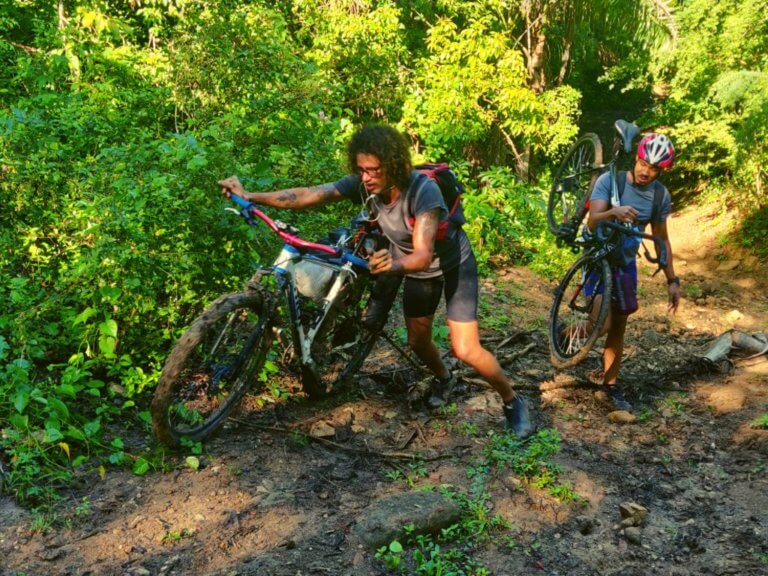
Mud track the second
Once we've cleared our bikes of the thickest mud as best we can and can pedal reasonably normally again, we continue on. Cows graze to the left of the route and watch us curiously, chewing.
The path is now grassy and realtively good to ride. But already at the next embankment I do not believe my eyes. What is that - a river?
Oh dear, if the others see that. I dare to be the first into the brown water and give the green light."You won't sink deep here, there's a stone slab underneath.""
But watch out - danger of slipping!
Slowly our column pushes itself through the mud river and up the hill behind it. So slowly we are really at the end of our strength.

When will we finally get there?
Completely exhausted, we let ourselves fall under a tree on the next slope. Crisis meeting is announced. And what a miracle - it is a guaya tree! We shake the tree, the fruits fall down and roll at our feet.
Happily smacking our lips, we eat the still somewhat unripe fruit, when suddenly a tractor driver passes by. He asks us before we come.
"Havana!", I exclaim and bite my tongue. Manno - nobody can know that because of Corona!
"Ah Arango," the farmer says."Si si," we quickly confirm.
"In 2 kilometers you'll be on the highway, there's the village of Santa Barbara," he explains to us. Phew - only 2 more kilometers to civilization! So the worst is behind us.

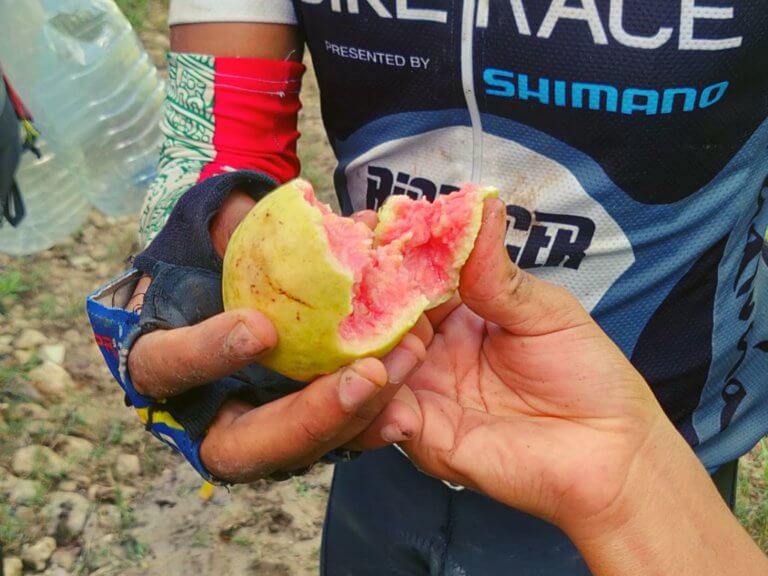

Finally a foothold under our feet
Without further problems we reach the country road, but the longed for village with a cafeteria remains missing. Santa Barabara then seems to be the collection of three huts in the pampas, far away from each other.
Well super!
Before the wooden gates of the houses in each case a spiked cow skull pragt. Shuddering, I make to get away - this reminds me too much of old horror movies.



First mud, then uphill
We are glad to finally have asphalt under our wheels again, but this stretch is a real challenge.
The hills are steep and we have to fight our way up slowly in the lowest gear.
However, the view of the rocks of Jaruco (Escaleras de Jaruco) in front of us surrounded by banana trees and royal palms is breathtaking and spurs us on. Arriving at the next road junction, the town sign of Jaruco finally heralds the obvious destination.
We decide to gather the group here and then decide how to proceed.


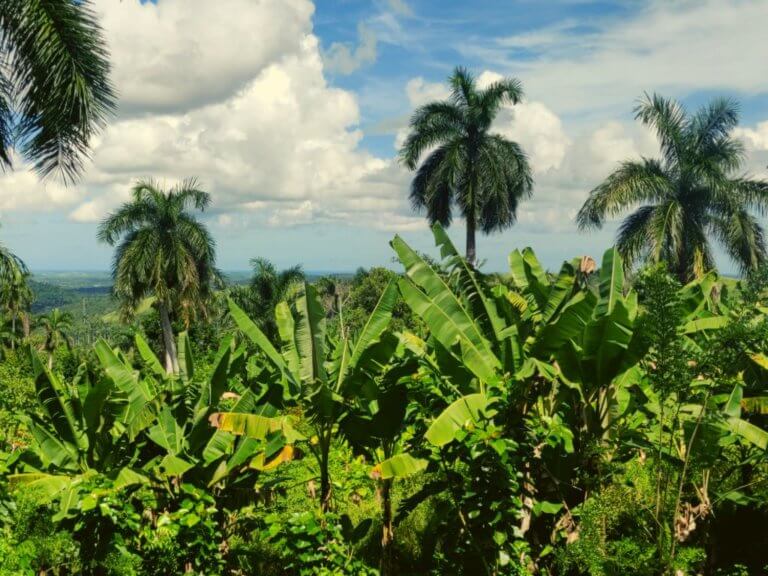
Street snack
Starved and flat as we are now at 1 p.m., we decide to use the waiting time for lunch right here at the roadside.
Yesterday I prepared a ricebowl with quimbombo, eggplant and lentils, Yanni even brought pork tenderloin. Cars whiz past us while we eat our cold but delicious lunch, tired but satisfied.


Camp preparation
When everyone is gathered, we first decide to drive together to the camp and put our things there. Afterwards, one part of the group should set up the tents, the other part should go out again and get drinking water in Tapaste. The empty canisters are to be filled with water for washing and cooking in the nearby well of a farmer.
The climbing rocks of the sector "La Jaula", which belongs to the mountain range of Jaruco is located on the road between Peru and Tapaste.
But the way into the forest is totally overgrown with bushes and marabu (stubborn Cuban weed plant with sharp spines). Carlos and Pablo get to work with their machetes and clear the way through the forest. On the way to the rock we find several of the nasty guao plants.
We take care not to get too close to any of them. A friend of mine once brushed one of these plants with her face and gave her a swollen face for days.

Mini campground
After about half an hour we can finally drag our backpacks and tents up to the rock. But the marabou and the branches get caught in our luggage and we realize that it is impossible to carry the bikes up to the rock in one piece.
Fortunately, a Cuban farmer family, who lives in the hut opposite the forest, makes their backyard available to us for parking. They don't want to have anything for it - the unconditional helpfulness of the poor locals in the country moves me once more.
The campground, however, I imagined something different. It lies between 2 rocks and is about 10 square meters wide.
How should we all fit in here and also cook? After all, we have about 6 tents with us.
The "toilet" is a rock, which one finds approx. 100 meters further away in the forest. I hope I don't have to visit it at night, I think to myself. The nice neighbors have given us some kerosene to light a campfire. Here we want to cook spaghettis for everyone in the evening.

Peru and its "supermarket
I decide to get off my bike again, despite my aching legs and buttocks, and go to the supermarket in Tapaste. I quickly collect the money for the purchases, because we need water and rum. When I arrive back down at the road I hear cheering exclamations.
We have visitors!
Part of the climbing clique from Havana has come to Jaruco as a surprise. But how is that possible!!! "We left Havana at 1 p.m. and took the country road.""
Apparently there is not such an attentive checkpoint on the route between Havana and Jaruco as we were told after all... That means we could have been in Jaruco in 2 hours from Havana without any problems. Instead we have been struggling through the muddy forest for hours since 5 am....
I swallow the frustration and chalk it up to a typical Cuban adventure. Our friends want to do some climbing in Jaruco and drive back to Havana in the evening. I decide to do the same, because the desire to camp is pretty much gone today.
Our climbing friends from Havana, who know the rock here very well, recommend us to buy water in the village of Peru, which is only 2 kilometers away. This is much closer than Tapaste.
So we get back on our bikes and ride to Peru surrounded by a valley with beautiful rocks and palm trees.
Once here, the villagers point out a small kiosk that looks more like a caravan or container. In fact, it says TRD on it, which identifies this container-like tin can as a supermarket.

There is only one long shelf in the kiosk, which consists of adult diapers, 6 different kinds of rum, and water bottles. The perfect combination of offerings for our basic needs today.
However, I feel a slight pang of regret for the villagers. Apparently there is nothing else available right now but rum and water. I guess you have to do all your other errands in the far away towns or bigger villages like Tapaste.
We stuff our backpacks full of water and buy Havana Club Ron Especial for the evening. Heavily laden, we head back to the rock.
Camping idyll
Back at the camp, the tents are already set up. For my tent would have been already no more place, more than 4 tents do not fit here in the crevice.
The guys are just trying to make a fire to be able to cook spaghetti in the huge cooking pot they brought. It smokes like crazy in the camp - there probably still need someone practice.
I take to my heels and head for the climbing walls.


Climbing sector "La Jaula”
It's already four o'clock in the afternoon and I want to get acquainted with the climbing crags of Jaruco before heading back.
Every climbing sector in Cuba has a different rock structure, my climbing friend Elvira explained to me. And indeed - the rocks in Jaruco are much more challenging compared to the boulder in Havana. The rock is relatively smoothplaca) and has few big holds, but all the more finger holes.
It is difficult to find a hold with the climbing shoe - the is a different climbing technique than in Havana and a lot of balance is required. The sector "La Jaula" is not as well documented as the climbing crags e.g. in Viñales, because hardly anyone comes to Jaruco. Anibal Fernandez (one of the "forefathers" of climbing in Cuba) told me that there are about 20 climbing routes in La Jaula, the easiest are V, 6a, 6b and the hardest is a 7c.
The bolts of the most difficult routes are already heavily rusted and need to be renewed. The easiest routes are still relatively stable and were provided with new bolts a few years ago. Three of the most experienced climbers in our group are pre-climbing three routes.
This allows the successors to climb top rope, which means the rope is only attached to the end of the route and there is no need to clip into the bolt during the route. This makes climbing easier and allows for faster changes between participants.


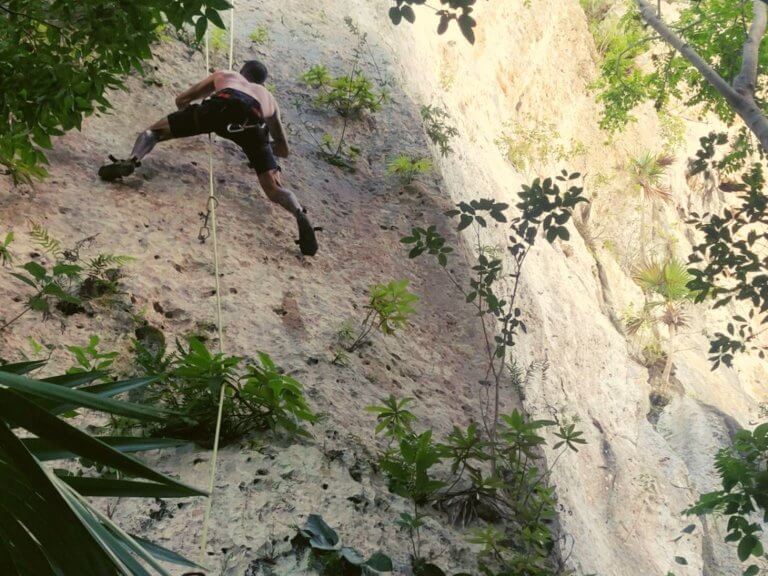
Above the palms
The longest route here at Sector La Jaula is a 6c and rises high above the treetops.
From up there you have a fantastic view over the valley. Elvira promises me to photograph the view from the top, because this route is unfortunately still too challenging for me.



Return trip with dreamlike sunset
It's 6pm and my friends from Havana and I are getting ready for the return trip. I am incredibly looking forward to my soft bed and a warm shower after the sweaty mud tour of this morning and with aching muscles all over my body.
We say goodbye to the part of the group that stays overnight at the rock and take the country road via Tapaste, Cotorro and San Miguel back to Havana. Without any mud or other problems, the bike route from Jaruco to Havana is a real pleasure. The sun sets and colors the green palm valley in yellow-orange light.
We enjoy the play of colors and still step on the gas, because the roads of Cuba are not safe in the dark with the sometimes quite deep potholes and unlit roads.
In the suburb of Cotorro, darkness already reaches us. The bike lights are brought out and we drive thoughtfully and slowly.
Arrived at home, I fall exhausted, but still quite dazed by the many new impressions and adventures of today immediately into bed.



Hints for a bike tour to Jaruco and for climbing and camping at the rock La Jaula
The climbing sector La Jaula is located on the asphalt road via Cotorro about 40 km from Havana. On the way there, however, we first went to Las Minas and then on to Arango.
From Arango we continued to Santa Barbara via the MTB routes that are regularly used for MTB competitions and from there to Jaruco.
This route, including climbing and tent luggage, is not recommended as an outward route, as it can still hold great mud tracks for you even days after the last rainfall.
However, the area around Jaruco is excellent for a one-day bike tour from/to Havana.Mountain bikers can take the route from Arango to Santa Barbara.
Those who prefer the aphalt road can follow this recording:
On this day we rode to the great viewpoints on the Escaleras de Jaruco (of which 5 km on the Escaleras de Jaruco on a MTB route on the mountain - very nice, easy MTB route).
In Jaruco, unforgettable panoramas await you: the valley covered with many palm trees and the outstanding white-gray rocks of the nature reserve of Escaleras de Jaruco.
The recommended viewpoints are the Mirador de Jaruco and (for those of you who don't mind a steep climb) the even higher one from Restaurant El Arabe.Here you can see from down to the sea for kilometers over the whole valley with several reservoirs (Embalse San Miguel, Embalse Jaruco, La Coca).
A secret tip from me: the small Cuban village Castilla.It is an excellent place for a picnic break with a fantastic view of a lake, cow pastures and the mountains of Jaruco behind it.
Something edible you can get around Jaruco in El Peru (water, rum, possibly rolls and Cuban juice and soft drinks) or in Tapaste (everything). If you like to eat in a real restaurant during your bike tour, you can do this in the restaurant El Arabe. This state-run establishment is a restaurant decorated in noble Arabic style. Food typical rustic, Cuban, toilets seeee very Cuban (no water, no toilet paper).
Camping and climbing in Jaruco at La Jaula rock should be well planned and best done with a local climber who knows the way to the rock and can handle a machete and knows the climbing routes. As mentioned, some of the climbing routes are not recommendedbecause the bolts have not been maintained for a long time and are oxidized .
If you don't want to camp in the middle of the forest among the rocks, you can do it in the meadows around the rocks. Water for washing, drinking and cooking must be obtained in Peru or Tapaste. Food etc must all be taken with you as there may be nothing to buy in Peru.
The climbing routes in Jaruco are rather less suitable for climbing beginners,as there are only 1 or 2 routes with difficulty grade V, which I also found very challenging, as the rock structure is very smooth, unlike in Havana, and requires good balance and technique.
Be sure to take insect repellent and anti-allergic and beware of the poisonous guao plants. giftigen guao plants-Pflanzen in Acht nehmen.
This might also be interesting for you
Climbing off the beaten track in Cuba - camping at the climbing rock of Jaruco
Vor mir sehe ich eine matschfreie Weggabelung. Endlich! Der Schweiß...
Read moreExkursion zum neuen Kletterspot in Cojimar
Behutsame setze ich einen Fuß nach dem anderen auf und...
Read moreKlettern in Kuba – Die Höhlenwelt von Viñales
Einen riesigen Stalaktit im Klammergriff hänge ich an der Route...
Read more

